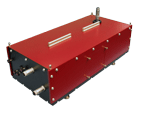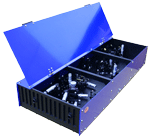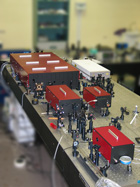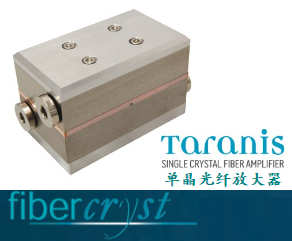公司简介
Atseva是位于美国科罗拉多的重点研发和生产超快激光系统及相关设备的公司。飞秒激光的世界是迷人的,但自从它诞生以后,一直是相当昂贵的。Atseva公司的愿景是让任何实验室和行业用户能用得起飞秒激光器。因此,Atseva的解决方案是高性价比,可靠的和用户友好的。此外,大公司往往集中在生产几个系列的产品,而忽略定制化的需求,Atseva提供更多的定制化解决方案,以适应任何非传统的,新的应用。
Atseva的产品线涵盖了许多不同领域的应用,如:物理,生物,医学,多光子激发显微镜应用,泵浦 - 探测光谱,光学相干断层扫描,材料沉积,表面结构,双光子聚合等等。目前,Atseva的科研针对下面的热点开发产品,如:开发高功率光纤放大器,在气体中的波长转换和脉冲压缩,太赫兹波产生和超短飞秒脉冲在微加工领域的应用等。
产品列表
LASERS

| Product | Pulse Duration | Wavelength | Average Power | Pulse Energy | Repetition Rate |
|---|
| TeMa | <100-<200 fs | 1050±5 nm | >3.5-6 W | >50->85 nJ | 70 MHz |
| Product | Pulse Duration | Wavelength | Max. Average Power | Max. Pump Power | Spectrum width |
|---|
| TiF-15 | <15-30 fs | 760-840 nm | >500 mW | 6 W | > 70 nm |
| TiF-50 | <50 fs | 730-950 nm | >1.2 W | 10 W | >20 nm |
| TiF-100 | <100 fs | 715-980 nm | >1.5 W | 10 W | >10 nm |
| Product | Pulse Duration | Wavelength | Average Power | Pulse Energy | Repetition Rate |
|---|
| CrF-400SP | <75 fs | 1230-1270 nm (fixed) | >400 mW | > 4 nJ | 95 MHz |
| CrF-450TP | <65 fs | 1230-1270 nm (tunable) | >450 mW | > 4nJ | 96 MHz |
| CrF-700SP | <75 fs | 1230 -1270 nm (fixed) | >700 mW | > 7 nJ | 95 MHz |
| CrF-700SP-L | <140 fs | 1265 +/-15 (fixed) | >560 mW | > 20 nJ | 30+/-2 MHz (fixed) |

| Product | Pulse Duration | Wavelength | Average Power | Pulse Energy | Repetition Rate |
|---|
| PErL | 250 fs...5 ps | 1560 nm | >50 mW | 0.8 nJ | 60 MHz |
| EFO | 80...250 fs | 1560 nm | 10...250 mW | 0.15...3.5 nJ | 25-80 MHz |
| EFOA-SH | 100...120 fs | 780/1560 nm | 80/160 mW | 1.1/2.2 nJ | 70 MHz |
| EFOA-UB | - | 1100-2000 nm | >150 mW | - | 70 MHz |
| EFOA-SH-UB | <150 fs | 780/1560/ 1100-2000 nm | 50-150 mW | - | 70 MHz |
| YFOA | 200...300 fs | 1030...1064 nm | 100-2000 mW | 1.6...33 nJ | 60 MHz |
| ANTAUS | <350 fs | 1030; 1040;
1050 nm | >5000 mW | >2 uJ | 2,5 MHz |

The TiC CW tunable laser is the choice with applications where tuning range and high average power level are a must, such as spectroscopy, semiconductor research and many more. The laser system features titanium-sapphire active medium for obtaining broad tuning range of 700 to 1000 nm with linewidth of <45 GHz. The system is equipped with a birefringent Lyot filter for manual or USB-controlled wavelength tuning*. Optional thick and thin automated etalons can be installed into the resonator cavity to bring the linewidth down to <2 GHz. Windows PC software is provided with the laser system for easier tuning and calibration. Learn more... |  |
 LF-100 Cr:F CW Solid-State Femtosecond Laser System LF-100 Cr:F CW Solid-State Femtosecond Laser SystemThe LF-100 is a chromium-forsterite continuous-wave tunable laser system with wavelength range from 1210 to 1290 nm.
The linewidth is limited by 10 cm-1 while the output power is >400 mW (with 10 W pump).
The system is suitable for various microscopic and spectroscopic applications in the IR region.
The system can also be equipped with a 10 W integrated pump laser (LF-100P). Learn more... |  |
AMPLIFIERS

The REUS family of amplifiers comprise a femtosecond seed oscillator (TiF-20F or fiber EFOA-SH), stretcher, Faraday isolator, Pockels cell with control and synchronization unit, regenerative amplifier, pulsed amplifier pump laser and compressor. The system may be equipped with an additional Pockels cell for contrast improvement. The cell enables the user to get "pulse-on-demand" operation and reduce the repetition rate to the required values. All elements are gathered into a single box on a thick breadboard, thus providing reliable and stable generation and hands-free operation. Learn more…
|  |
The MATEKO femtosecond amplifier is designed to provide mJ-level output by amplifying pulses from a Ti:S or fiber ultrafast seed oscillator. The amplification ratio in such a system is more than 10^6 and happens in a Ti:S crystal during several passes while pumping by a Q-switched 515-532 nm laser. The hybrid system comprises two amplifiers: a regenerative stage and a multipass stage, thus enabling higher pulse energies. A single pump laser is used to pump both stages which reduces the cost of the system and boosts stability and performance. Learn more… |  |
 FREGAT Cr:F femtosecond amplifier system
FREGAT Cr:F femtosecond amplifier system
 Wavelength of 1240 nm Wavelength of 1240 nm
 Pulse energy up to 1 mJ@10 Hz Pulse energy up to 1 mJ@10 Hz
 Pulse duration <120 fs Pulse duration <120 fs
 Custom systems with peak power >1TW Custom systems with peak power >1TW
 Synchronization electronics Synchronization electronics
 All-in-one design All-in-one design
| 
 Download .PDF Download .PDF |

 TETA Yb femtosecond amplifier system
TETA Yb femtosecond amplifier system

 AVET Ti:S Femtosecond TW System
AVET Ti:S Femtosecond TW System

FS SPECTROSCOPY
 Astrolabe tabletop femtosecond SFG/CARS spectrometer.
Astrolabe tabletop femtosecond SFG/CARS spectrometer.

DIAGNOSTICS

| Product | Pulse Duration | Wavelength | Input Repetition |
|---|
| AA-20DD | 10-30000 fs | 450-2000 nm | 10 Hz |
| AA-M | 20-12000 fs | 450-2000 nm | >10 kHz |
| IRA-3-10 | 30 fs-50 ps | 3-10 µm | <3 kHz |
| IRA-0.45-3 | 50 fs-250 ps | 450-3000 nm | 10 Hz-80 MHz |
| ASF | 20 fs - 2 ps | 700-2000 nm | 1->10 Hz |
 SPIDER pulse diagnostic system
SPIDER pulse diagnostic system
 Down to 6 fs measurement Down to 6 fs measurement
 Single-shot sensitivity 10 uJ Single-shot sensitivity 10 uJ
 Oscillator and amplifier measurement Oscillator and amplifier measurement
 650 to 1050 nm possible wavelengths 650 to 1050 nm possible wavelengths
 USB PC connection and PC acquisition software USB PC connection and PC acquisition software
|   Download .PDF Download .PDF |


The Comet third-order scanning cross-correlator (aka TOCC) offers its 10^10-wide dynamic range and 950ps-broad temporal range at your service. It can give comprehensive information about the ASE of the amplifier, pulse pedestal, pre-and post-pulses's structure and shape. The unit also gives information about the pulse intensity cross-correlation function and measure pulse duration and shape. The user can also select the desired narrow area (say, +/- 50 ps from the peak) for faster scanning speed. The Comet communicates with a PC via USB and acquisition and analysis software is included in the package. Learn more... |  |
The Comet-A cross-correlator is specifically developed for measurement of pulse duration of femtosecond and ps OPAs. Knowing exact pulse duration and pedestal information is essential for many applications, especially with the OPAs as there are quite few devices that can fulfill the task. The advantage of the cross-correlation method is that it can display pre- and post-pulse structure while autocorrelation will show symmetric curve. However, if you require higher resolution, please refer to our IRA-3-10 autocorrelator for IR measurements. Learn more... |  |
 Spectrometer ASP-IR
Spectrometer ASP-IR

COMPONENTS
 APC dispersion compensation system
APC dispersion compensation system
 Negative dispersion up to -13000 fs^2@800 nm Negative dispersion up to -13000 fs^2@800 nm
 Transmission >90% Transmission >90%
 Integration into Atseva’s laser systems Integration into Atseva’s laser systems
 Automated adjustment Automated adjustment
|   Download .PDF Download .PDF
|

 Gas Compressor Compulse
Gas Compressor Compulse
 Up to 1:10 compression ratio
Up to 1:10 compression ratio
 Energy efficiency 50%
Energy efficiency 50%
 Input pulse energy up to 1 mJ
Input pulse energy up to 1 mJ
 800 and 1058 nm standard models
800 and 1058 nm standard models
 Download .PDF
Download .PDF
 OG pulse picker systems
OG pulse picker systems
 Possible wavelength: 250 - 2100 nm Possible wavelength: 250 - 2100 nm
 Adjustable amplitude up to 12 kV Adjustable amplitude up to 12 kV
 HV pulse adjustable delay HV pulse adjustable delay
 HV pulse duration from 3 to 1250 ns HV pulse duration from 3 to 1250 ns
 Fast rise time down to 1 ns or less Fast rise time down to 1 ns or less
 Single-shot up to 100 kHz picking rate Single-shot up to 100 kHz picking rate
 USB control and LabView drivers USB control and LabView drivers
 Low jitter <200 ps Low jitter <200 ps
 Built-in optical trigger Built-in optical trigger
 Two additional sync channels Two additional sync channels
|   Download .PDF Download .PDF
|


The ASG frequency doubler provides smooth harmonic generation from a fundamental beam of Ti:S (710-960 nm), Yb (1020-1070 nm) and Cr:F (1250 nm) femtosecond laser systems. The unit is a compact portable system comprising the conversion crystal and all optics necessary for beam adjustment. The generators offer high conversion efficiency, virtually no beam distortion and low pulse broadening for ultrafast applications. Learn more... |  |
The ATsG frequency conversion unit provides smooth second and third harmonic generation from a fundamental beam of Ti:S (750-900 nm), Yb (1020-1070 nm) and Cr:F (1250 nm) femtosecond laser systems. The unit is a compact portable system comprising the conversion crystals and all optics necessary for beam adjustment. The generators offer high conversion efficiency, virtually no beam distortion and low pulse broadening for ultrafast applications. Learn more... |  |
 THz Generator Tera-AX
THz Generator Tera-AX
 Central frequency 1 THz Central frequency 1 THz
 Spectrum width 1.5 THz Spectrum width 1.5 THz
 Pulse duration <1 ps Pulse duration <1 ps
 THz pulse energy up to 1 nJ THz pulse energy up to 1 nJ
 EO-AX THz detector option EO-AX THz detector option
|   Download .PDF Download .PDF |

Raman Shifters
 Conversion efficiency up to 30%
Conversion efficiency up to 30%
 Various active media with different frequency shift values
Various active media with different frequency shift values
 Input pulse energies up to 100 mJ
Input pulse energies up to 100 mJ
 Standard models for 800/1058/1250 nm
Standard models for 800/1058/1250 nm
Wavelength after conversion of different sources in various active media:

 Download .PDF
Download .PDF
 OAFP and OAGP optical attenuators
OAFP and OAGP optical attenuators

![]()
![]()
![]()


![]()


 FREGAT Cr:F femtosecond amplifier system
FREGAT Cr:F femtosecond amplifier system
 TETA Yb femtosecond amplifier system
TETA Yb femtosecond amplifier system

 AVET Ti:S Femtosecond TW System
AVET Ti:S Femtosecond TW System

 Astrolabe tabletop femtosecond SFG/CARS spectrometer.
Astrolabe tabletop femtosecond SFG/CARS spectrometer.
![]()
 SPIDER pulse diagnostic system
SPIDER pulse diagnostic system

![]()


 Spectrometer ASP-IR
Spectrometer ASP-IR

![]() APC dispersion compensation system
APC dispersion compensation system
 Gas Compressor Compulse
Gas Compressor Compulse![]() Up to 1:10 compression ratio
Up to 1:10 compression ratio![]() Energy efficiency 50%
Energy efficiency 50%![]() Input pulse energy up to 1 mJ
Input pulse energy up to 1 mJ![]() 800 and 1058 nm standard models
800 and 1058 nm standard models  OG pulse picker systems
OG pulse picker systems
![]()


 THz Generator Tera-AX
THz Generator Tera-AX

![]() Conversion efficiency up to 30%
Conversion efficiency up to 30%![]() Various active media with different frequency shift values
Various active media with different frequency shift values![]() Input pulse energies up to 100 mJ
Input pulse energies up to 100 mJ![]() Standard models for 800/1058/1250 nm
Standard models for 800/1058/1250 nm
 OAFP and OAGP optical attenuators
OAFP and OAGP optical attenuators












